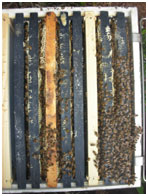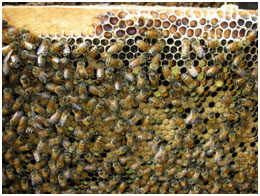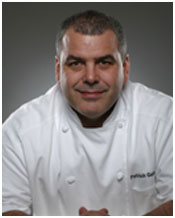Heywood’s Provision Company, Atlanta, GA
An Artisan Meat Processor & former Executive Chef Dunwoody Country Club
by David Meyers
Patrick – You have a very interesting story to tell on how your influenced a significant number of Atlanta club chefs into implementing a successful “Farm to Fork” program utilizing local growers. Tell us how your greater community has embraced your vision and some noteworthy challenges getting the concept launched.
A – Farm to Fork or Farm to Table is a popular term right now, prevalent in most major markets and in large part, now expected by membership of most clubs. A Farm to Table operation is just that, an approach that sources fresh products directly through the Farmer or Co-Ops, and in some cases through Wholesalers that has decided to represent the producer. In most cases it simply means that you are buying locally (within 1 days travel) maximizing the freshness, flavors and nutritional value of seasonal produce, meats and dairy. In clubs, this is still something quite new to many, although Savvy Chefs have incorporated local ingredients in parts of their menus for years. Now, thanks in part to culinary industry icons and Michelle Obama, it is hitting its stride on mainstream, a trend likely to continue. And of course there are various Pro’s and Con’s to the system and approach so I suggest starting with just a few items and measuring it as you go.
So, where do you start? The best answer I can give is starting with produce first as it is generally the most available. Depending on where you live, Poultry, Beef, Pork, Dairy and Cheese may be available as well. It is very important that you understand the Seasons in the area in which you live. You might get great Strawberries in South Florida in January, but that not realistic in Indianapolis that time of year. Knowing what is available in your area and when it is available will be a tremendous help. For example, our Collard Greens finished in March, then the Carrots start to come in for April, Green Beans in May, Heirloom tomatoes galore for the coming months and more. By knowing what’s out there, we are able to buy the best product at the lowest prices at the peak of flavor and freshness.
How do I find it? Start by asking other Chefs, especially ones that are making a name by using local ingredients. Ask your Vendors too. We have a large State Farmers Market here in Atlanta, so there are local products available most of the year. I tell my produce partner to choose local first, then if there is nothing available, find the next best. As an ACF Chapter Director, I spearheaded the concept of hosting a meeting open to farmers and chef establishing dialogue between growers and uses. Initially I thought to invite few local farmers I supported allowing them to show their products to a small group of chefs. Well, the word got out and one thing lead to another, ultimately we had over 40 Farmers, 400 Chefs and Vendors packed into the Ballroom and Main Kitchen with interactive cooking demos and tastings. It was a blast! It went so well, we made the local news and were invited by the Georgia Department of Agriculture to help them do a Georgia Grown Food Show for them! The movement continues!!!
Let me also share with you of some challenges when working with local foods and food sources.
- Availability – some famers only have so much quantity and consistency can be an issue.
- Usage – If I buy a Whole Pig or Calf, I have to find a use for everything! Sometimes, you are asking what do I do with one Calves Tongue, and two Pork tenders?
- Price – despite what you think, many local ingredients can be as much or more than the commodity products you are buying now, particularly if organic. The trade off is better shelf life, higher yields and knowing exactly where the product comes from. With all the food recalls in the past 5 years, I am happy to say that we have not had to deal with that yet.
To help get Members support and interested, I recommend a few things.
- First, make sure that you Market menu items correctly. Let them know it’s a Local ingredient.
- Second, make sure your FOH management and service staffs are on board. It may be a great dish, but if you don’t educate the servers and they don’t sell it, then it won’t do you any good.
- Third, let Membership know what you are doing through various communication methods. When I explained to my members that we are the only Club trying to source 50% or more of our products from Local suppliers, they took it as a source of pride and have supported it for which I am very grateful.
As a result, I often have other Club Chefs call me asking how I implemented the program and where I get this or that from. I’m always happy to share with them my resources as I’m really happy all this effort is catching on.
Patrick – I guess it’s fair to suggest your passion for agricultural caused you to catch Bee Fever?
 A – Beekeeping – What’s all the buzz about?
A – Beekeeping – What’s all the buzz about?
The first question people always ask me is why? Why did I decide to become a beekeeper?
I decided to try my hand at beekeeping earlier this year. As an Organic gardener for the last 10 years, I have known that without bees, the world would loss 1/3 of its food supply! Bees are an integral part of our existence and we need them more than they need us!
I had an epiphany last year as our garden’s output was substantially lower than in previous years, even with a small collection of Bumblebees that we were keeping. I started to think that maybe limited plant pollination was the culprit. So, personally knowing two beekeepers, one a local professional beekeeper, the other Tom Griffiths, CMC, I called upon their expertise and read a bunch more, ultimately compelling me to ordered my first “Nuc” or Nucleus, a small junior hive. I brought the colony home the first week in April, and I must say, it been one of the most rewarding things I have ever done. And Yes I was nervous holding over 5000 Bees in my hand wondering “What are you thinking”? But watching these tiny creatures work, seeing them build a Honeycomb, then fill it with honey is simply amazing! My family really enjoys them as well – My youngest son is my main helper and my oldest is always cautiously ready to jump in as well. Many times I come home to find my wife and kids sitting on the old stumps by the hive, simply in awe watching them. They say it’s better than TV.
 But what about the stinging?
But what about the stinging?
Foremost you need to realize that Bees do not want to sting you as they know that means their demise. Bees only sting as a defensive measure. Each variety of Bees is different, there are several species and I use Italian bees, which are considered quite docile and a bit more common in the south. Many in the Northern climates use Russian bees, which can be a bit more defensive and aggressive. So, first thing is that you are calm and not show fear. Many beekeepers believe the Bees sense fear – that’s my sense too. The Smoker is the most important thing you have that calms the bees, making them less defensive. Many Beekeepers wear full suits and veil protecting them from stings however many do not. Personally I have used a Veil once – the very first time I got the Bees – however since then I use nothing and have only been stung twice; both times my fault. My wife, children and our 50 friends we have had over since we took on the hive have not been stung once. Of course this does not count the possibility of ‘Africanized’ Bees moving into your hive. This is still rare in the Northern markets but in the South, they can be a problem. Many people know of them as Killer Bees, and they can be dangerous if not handled correctly, but they are proving to be more valuable than previously thought. They are disease and pest resistant (something that is affecting many Hives now) and they can be just as productive as our standard Honey Bees. You just have to understand them first.
If you are at all interested in Beekeeping, I would highly suggest you check into it. You don’t need a huge space (my lot is 1/2 acre) and they require minimal maintenance, mostly when you get started. We will be harvesting our first bit of Honey very soon and we are all looking forward to it. As a Chef, it just helps me understand a bit more about the world of Food that surrounds all of us.
As a good friend of mine says “Bee Healthy, Bee Happy”
Patrick – Finally, your approach to cuisine is very thoughtful start to FINISH. You are one of the original fellows in the club world who has gained HACCP certification, a sanitation standard certainly to be the industry wide in the near future. Tell us what you can about how it has changed your operational approach and overall knowledge of food safety.
A – I was recently HACCP certified, being proactive to handling practices with my guest’s health in mind. A practice originally limited to the manufacturing segment now moving toward a government imposed requirement at individual operation levels. This requirement will cause a big shift in the way we conduct and report our work.
What is HAACP? HAACP is an acronymic for Hazard Analysis and Critical Control Points, a system designed by the Pillsbury Company during early NASA missions assuring that the food being packaged was safe for consumption in space. Pillsbury designed a monitoring system that did multiple things including identified potential Hazards in foods and placed controls eliminating or greatly reducing safety in food.
As example, we all know that Fresh Meat needs to be kept cold to prevent spoilage. To assure a healthy product, it needs to be processed in refrigerated conditions, transported and stored cold until it is ready to cook. Under HACCP practices, the end processor or the chef, needs to track when the product was received, what temperature it was when it was received, what temperature the refrigerator was when stored, how long it was outside of refrigerated conditions before cooking, what temperature it was cooked to, and you need to report in each case, who was the person in charge of that particular process. This recording process and more are part of a detailed HACCP plan, and, for a small operation, it can be daunting. Large processors like Tyson, IBP, Smithfield and other companies dealing with potentially hazardous food, even grocery stores, have HACCP plans in place. It will limit legal liability to the company if it can prove that it has done everything it can to prevent contamination of food.
As health and food safety issue become of greater public interest many health departments are starting to demand HACCP plans for operations that Cure, Smoke, Low Temp Cook, Sous Vide, Dry Age, Pickle, Vacuum package or a practice sometimes referred to as “Potentially Hazardous Processing”. These rules vary by State, even County, but they all center on a central theme – Public Health Safety and Accountability – proving you are minimizing the Hazards. The expecting guidelines are that used by the USDA and FDA inspected operations.
As artisan cuisine and intensive flavors remain in vogue, many chefs are turning to newer preparation methods including Sous Vide and Low Temp Cooking as well as time honored approaches including Dry Aged Meats, Dry Cured Salami’s and Sausages however unfortunately, many Chefs do not have the proper training to produce these products safely. Accessing and using Nitrates and Nitites, Sodium Erythrobate and Immersion Circulators are well known but, I am not personally comfortable with these techniques yet. Many Chefs are not as cautious and there is growing concern that smaller operators may be poisoning our customers? In many ways this is the argument compelling government to catch-up with the Industry.
For now, there remains much confusion, as many Health Departments are implementing some unique rules while others are not. There is no question in my mind that HACCP type regulations are coming. It will in some ways dramatically change the way many of us work in our operations, but in the long run, I want to know that the ‘Homemade’ Salami is safe to eat.
So, I feel the most important thing we can do is regard the food we touch and constantly train our employees on the importance of techniques, cleanliness and best handling practices as, on a day in and out basis, we touch many lives with health and nutrition core to our purpose.
Editors Comments – What thoughtful insight and clear reminder of the seriousness of and vast knowledge we must possess as chefs, the many components contributing to a guest’s experience and as operators, how closely we hold our guest’s health in hand, all as result of our management abilities.



